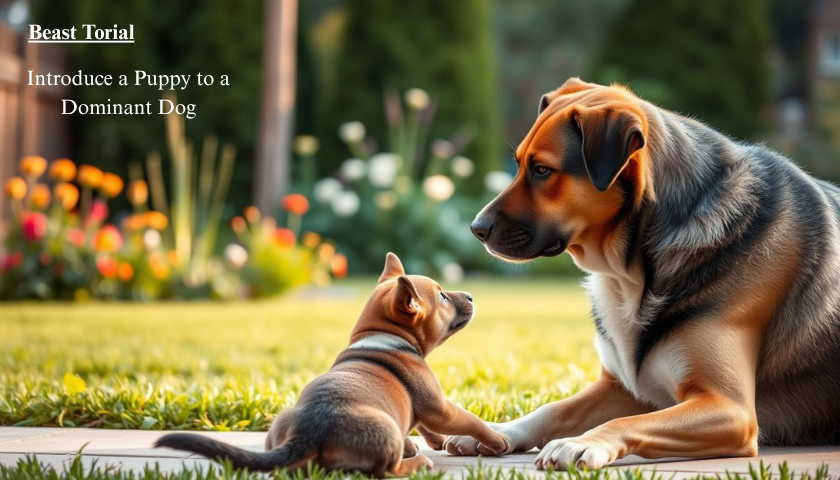Introducing a new puppy to a dominant dog requires careful planning. A smooth introduction is essential for a peaceful home. It involves understanding dog behavior, setting up a safe area, and introducing them slowly.
Understanding each dog’s body language is essential for a good introduction between dogs. Excellent guidance on puppy socialisation and handling dominant behaviours comes from the International Association of Animal Behaviour Consultants.
Contents
- 1 Understanding Canine Hierarchy and Dominance
- 2 Preparing Your Home Before the Introduction
- 3 Pre-Introduction Training for Your Dominant Dog
- 4 How to Introduce a Puppy to a Dominant Dog: The Step-by-Step Process
- 5 Managing the First Few Weeks Together
- 6 Conclusion: Building a Harmonious Multi-Dog Household
- 7 FAQ
- 7.1 What is the best way to introduce a puppy to a dominant dog?
- 7.2 How can I tell if my dog is dominant?
- 7.3 What are some tips for managing resources when introducing a new puppy to a dominant dog?
- 7.4 How can I desensitize my dominant dog to puppy sounds and smells?
- 7.5 What training exercises can help promote harmony between my dogs?
- 7.6 How long does it take for my dogs to adjust to each other?
- 7.7 Can I leave my dogs alone together after the introduction?
Key Takeaways
- Know how important slow introduction is.
- Get the dogs in a safe surroundings.
- Know the body language and behavioural signals.
- Apply techniques of positive reinforcement.
- Track the dogs’ behavior and change the introduction strategy if necessary.
Understanding Canine Hierarchy and Dominance
Dogs live in a hierarchical structure. Knowing this is key when introducing a new puppy. This hierarchy is built through complex behaviors and interactions among dogs.
What Makes a Dog “Dominant”?
Aggressive posturing, vocalizations, and resource guarding are just a few of the ways a dominant dog exhibits its control. Dominance goes beyond just aggressiveness. It also concerns leading and guiding the pack.
- Assertive body language
- Resource guarding
- Leading the way or initiating actions
How Puppies Fit into Pack Dynamics
Puppies obey older, more dominant dogs naturally. Consider the puppy’s position when you introduce it to a dominant dog. Puppies pick from dominant dogs social skills and boundaries.
For more information on puppy socialization, you can visit the American Kennel Club website.
Signs of Dominance in Your Existing Dog
It’s important to recognize signs of dominance in your dog before introducing a new puppy. Some common signs include:
- Growling or snapping when approached while eating or resting
- Pushing to be the first to exit or enter a room
- Mounting or standing over other dogs
Understanding these behaviors can help you manage the introduction process better.
Preparing Your Home Before the Introduction
Getting your home ready is key for a peaceful home when you bring a new puppy. This means taking a few important steps to make the transition smooth for both dogs.
Creating Separate Spaces for Each Dog
It’s important to have separate areas for each dog to lower tension and give them security. You can do this by setting up specific rooms or spots for each dog.
Setting Up Safe Zones with Gates and Crates
Baby gates or crates can make safe zones for your dogs. This lets them have their own space when they need it. For instance, a crate can be a cozy spot for your new puppy. A gated area can be a safe place for your dominant dog to go when needed.
Resource Management: Toys, Beds, and Feeding Areas
Managing resources well is key to avoid fights between dogs. Give each dog their own toys, beds, and places to eat. This reduces competition and stress.
As Stanley Coren, a renowned canine behaviorist, once said,
“Dogs are territorial animals, and they have a natural instinct to defend their territory and resources.”
So, it’s very important to manage these resources carefully.
Safety Equipment You’ll Need
To make sure the introduction is safe, you’ll need some important safety gear. This includes:
- Baby gates to block off areas
- Crates for safe zones
- Separate feeding stations
With these safety tools, you can greatly lower the chance of fights between your dogs.
Pre-Introduction Training for Your Dominant Dog
Getting a new puppy? Start with pre-introduction training for your dominant dog. This step is key to avoiding fights and creating a peaceful home.
Reinforcing Basic Obedience Commands
Before the puppy arrives, make sure your dog knows basic commands. “Sit,” “stay,” and “leave it” are essential. These commands help manage how the dogs interact. Training sessions boost your dog’s behavior and your bond.
Use treats and praise to encourage good behavior. This positive approach makes training fun and rewarding.
Desensitization to Puppy Sounds and Smells
Puppies can be loud and energetic. Their sounds and smells might upset your dog. Desensitizing your dog to these can reduce stress during the introduction.
Start by playing puppy sounds softly and gradually get louder. Also, introduce your dog to puppy smells like shampoo or toys. This helps them get used to the new scents.
Working with a Professional Trainer
Not sure about training or worried about your dog’s past behavior? A professional dog trainer can help. They offer personalized advice and create a training plan for your dog.
Looking for a certified trainer? Check out the Association of Professional Dog Trainers. They can connect you with a trainer near you.
| Training Aspect | Description | Benefits |
| Basic Obedience Commands | Reinforcing commands like “sit,” “stay,” and “leave it.” | Improves dog’s behavior, strengthens owner-dog bond. |
| Desensitization | Gradual exposure to puppy sounds and smells. | Reduces stress and anxiety during introduction. |
| Professional Training | Working with a certified dog trainer. | Personalized guidance, tailored training plan. |
How to Introduce a Puppy to a Dominant Dog: The Step-by-Step Process
When you bring a new puppy home with a dominant dog, a careful introduction is key. This method keeps both dogs safe and helps them live together peacefully.
First Meetings: The Neutral Territory Approach
Introduce the dogs in a neutral territory. Choose a place they’ve never been to avoid fights. It should be quiet and free from distractions.
Reading Body Language Cues
Watch for body language cues when they meet. Look for raised hackles, growling, or avoiding eye contact. If you see these, separate them and start again.
Controlled Home Introductions
When they seem okay, it’s time for a controlled home introduction. Keep the first meeting short. Make sure both dogs are on leashes or in a safe area.
Give treats and praise for calm behavior. Stay calm yourself, as dogs can pick up on your energy.
Gradual Increase in Interaction Time
Increase their time together in a calm, under control environment progressively after the first meeting. Look closely for any indicators of conflict; early intervention will help you to guide them. You can boldly let them spend more time together as their relationship deepens and they relax around one another.
Following these tested techniques and keeping aware of your dogs’ behavior will help you create a harmonic home and a peaceful relationship.
Managing the First Few Weeks Together
Getting a new puppy and a dominant dog to live together peacefully is important. The first few weeks set the stage for a happy home.
Establishing Routines That Respect Both Dogs
Make routines that work for both dogs. This means separate times for eating, playing, and exercise. This helps avoid fights and stress.
For instance, feeding them in different spots can lower tension. Also, giving them their own playtime helps prevent jealousy.
Key routines to establish:
- Separate feeding times and areas
- Independent play and exercise sessions
- Individual attention and training
Supervised vs. Unsupervised Time
Watching them closely in the early weeks is important. It lets you step in if there’s a problem. As they get used to each other, you can let them have more time alone.
But, don’t rush it. Start with short periods of time alone. Watch them closely to make sure they’re okay.
Training Exercises to Promote Harmony
Training is key to getting along. Teaching them basic commands like “sit” and “stay” helps. These commands help manage their interactions.
For more advanced training, check out the American Kennel Club website. It has lots of tips and exercises for homes with multiple dogs.
Some beneficial training exercises include:
- Desensitization and counterconditioning to reduce stress and reactivity
- Basic obedience training to establish clear communication
- Positive reinforcement training to encourage good behavior
By using these strategies, you can help your dogs live together better.
Conclusion: Building a Harmonious Multi-Dog Household
Adding a puppy to a home with a dominant dog needs patience, training, and careful steps. Understanding dog hierarchy and dominance is key. Preparing your home and following a step-by-step introduction process helps create harmony.
It’s important to establish routines that respect both dogs. Supervised interactions and gradual increases in time together prevent fights. Training, like basic commands and getting used to puppy sounds and smells, also helps.
To keep your home peaceful, use tips like managing resources and giving each dog their own space. Safety equipment is also a must. Getting help from a professional trainer can solve specific problems.
With careful planning and attention, you can make a peaceful home for your dogs. Follow these tips and stay committed to their happiness. This way, you can enjoy a harmonious home where all dogs flourish.
FAQ
What is the best way to introduce a puppy to a dominant dog?
The best method is the neutral territory approach. This means the first meeting happens in a place neither dog considers their own. For more on this, check out the International Association of Animal Behavior Consultants.
How can I tell if my dog is dominant?
Dominant dogs often stand tall and make direct eye contact. They may growl or snap when challenged. For more on dog behavior, visit the American Kennel Club’s website.
What are some tips for managing resources when introducing a new puppy to a dominant dog?
Make sure both dogs have their own spaces for eating, sleeping, and playing. Watch them closely and use baby gates or crates for safety. The Certified Applied Animal Behaviorist website has great advice on managing resources.
How can I desensitize my dominant dog to puppy sounds and smells?
Start by exposing your dog to the puppy’s sounds and smells slowly. Begin with a low level and reward calm behavior. For more guidance, check out the Karen Pryor Academy.
What training exercises can help promote harmony between my dogs?
Teach commands like “sit,” “stay,” and “leave it.” Also, try exercises that help them relax. The Victoria Stilwell Positively website has lots of positive training tips.
How long does it take for my dogs to adjust to each other?
Adjustment time depends on the dogs and how they’re introduced. It can take weeks to months. Be patient and keep rewarding good behavior.
Can I leave my dogs alone together after the introduction?
Start with close supervision. As they get more comfortable, you can let them be alone together more. But always keep an eye on them for their safety.




